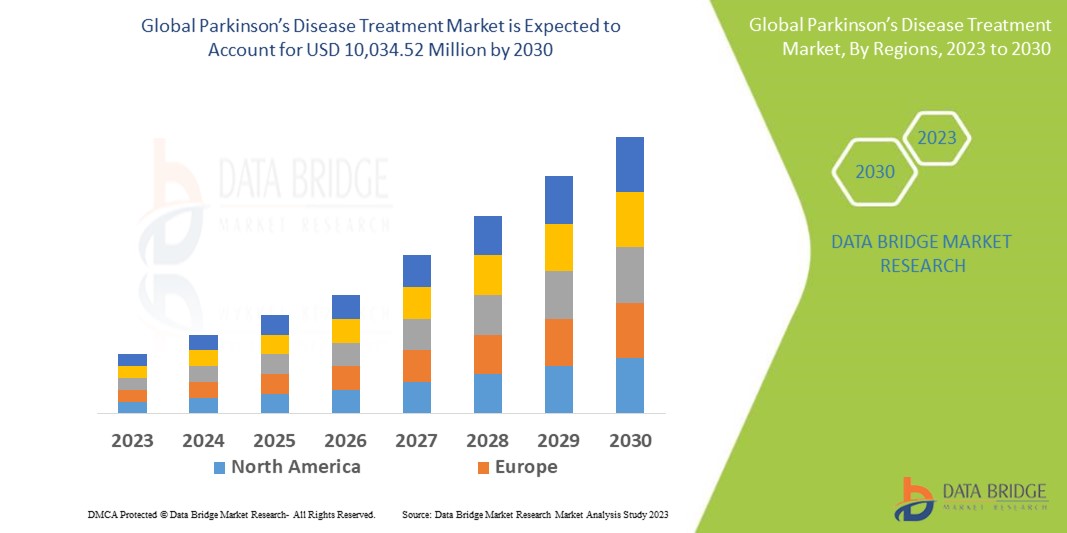Rising Prevalence and Advancements in Therapeutics Propel the Global Parkinson’s Disease Treatment Market
Global Parkinson’s Disease Treatment Market – Industry Trends and Forecast to 2030
https://www.databridgemarketresearch.com/reports/global-parkinsons-disease-treatment-market
Data Bridge Market Research analyses that the Parkinson’s disease treatment market which was USD 4,999.18 million in 2022, would rocket up to USD 10,034.52 million by 2030, and is expected to undergo a CAGR of 9.10% during the forecast period.

The global Parkinson’s disease treatment market is witnessing steady growth, driven by increasing disease prevalence, an aging population, advancements in drug development, and a growing focus on precision medicine. Parkinson’s disease (PD) is a progressive neurodegenerative disorder characterized by motor symptoms such as tremors, rigidity, and bradykinesia, as well as non-motor symptoms including depression, sleep disorders, and cognitive impairment. As awareness and diagnostic capabilities improve, the demand for effective and personalized treatment solutions continues to rise globally.
Market Overview
Parkinson’s disease affects millions of individuals worldwide, and its prevalence is expected to increase substantially due to demographic changes and improved longevity. The market encompasses various treatment options such as dopaminergic drugs, anticholinergic agents, MAO-B inhibitors, COMT inhibitors, and advanced therapies including deep brain stimulation (DBS) and gene therapy. The growing focus on early diagnosis and effective management of symptoms has spurred investments from pharmaceutical companies and healthcare providers alike.
The increasing collaboration between research institutions and drug manufacturers has led to the development of innovative therapies aimed at slowing disease progression rather than merely alleviating symptoms. Additionally, the emergence of combination therapies and novel drug delivery systems is expected to further enhance treatment efficacy and patient adherence.
Key Market Drivers
1. Rising Prevalence of Parkinson’s Disease
The global burden of Parkinson’s disease has grown significantly over the past few decades. According to health estimates, the number of people living with PD is projected to double by 2040, primarily due to aging populations in regions such as North America, Europe, and Asia-Pacific. This growing prevalence is a major driver for the expansion of the treatment market, creating an urgent need for effective and affordable therapies.
2. Advancements in Drug Development and Delivery
The pharmaceutical industry has witnessed remarkable progress in the development of drugs targeting Parkinson’s disease. While levodopa remains the gold standard for symptom management, new formulations and adjunct therapies are improving its bioavailability and reducing side effects. The introduction of extended-release formulations and non-oral delivery systems, such as transdermal patches and inhalable drugs, enhances patient convenience and compliance.
In addition, research into disease-modifying therapies, including neuroprotective agents and gene-based treatments, is gaining momentum. Biotech firms are investing heavily in developing drugs that target alpha-synuclein aggregation — one of the key pathological features of Parkinson’s disease — which could revolutionize treatment outcomes.
3. Technological Innovations in Medical Devices
Deep brain stimulation (DBS) has become a well-established therapy for patients with advanced Parkinson’s disease who do not respond adequately to medications. Technological advancements in DBS devices, including rechargeable and adaptive systems, are improving treatment precision and patient comfort. Furthermore, the integration of artificial intelligence (AI) and machine learning in neurostimulation devices allows real-time adjustments based on patient needs, providing personalized and efficient therapy.
4. Increasing Research Funding and Clinical Trials
Government agencies, non-profit organizations, and private enterprises are significantly investing in Parkinson’s disease research. Numerous clinical trials are exploring new pharmacological agents, stem cell-based therapies, and immunotherapy approaches aimed at halting disease progression. The rising number of clinical studies reflects the expanding scope of therapeutic possibilities and strengthens the overall market outlook.
5. Growing Awareness and Early Diagnosis
Public health campaigns and awareness programs have improved understanding of Parkinson’s disease among both patients and healthcare providers. Earlier diagnosis enables more effective disease management and enhances the quality of life for patients. With the availability of improved diagnostic imaging techniques and biomarkers, healthcare professionals can detect PD at earlier stages, supporting timely intervention and better therapeutic outcomes.
Market Challenges
Despite positive growth trends, the Parkinson’s disease treatment market faces several challenges. The high cost of advanced therapies, particularly in low- and middle-income countries, limits accessibility for many patients. Moreover, the lack of curative treatment continues to be a major hurdle, as existing drugs primarily manage symptoms rather than halt or reverse disease progression.
Another significant challenge lies in the side effects associated with long-term use of levodopa and dopaminergic drugs, which can lead to motor fluctuations and dyskinesias. This necessitates ongoing adjustments in medication regimens and highlights the need for more effective long-term solutions. Furthermore, the complexity of Parkinson’s disease pathology complicates drug development, as it involves multiple genetic and environmental factors.
Regional Insights
North America holds a major share of the global Parkinson’s disease treatment market due to the high prevalence of PD, strong healthcare infrastructure, and active research environment. The U.S. leads the region with a robust pipeline of investigational drugs and a growing adoption of advanced therapies such as DBS and infusion-based treatments.
Europe follows closely, supported by government-funded research programs and widespread healthcare coverage that facilitates early diagnosis and access to treatment. Countries such as Germany, the U.K., and France are prominent contributors to the region’s market growth.
The Asia-Pacific region is projected to experience the fastest growth rate during the forecast period, fueled by a large patient base, rising healthcare expenditures, and increasing awareness of neurodegenerative diseases. Rapid urbanization and improved access to neurological care are further driving demand in countries like China, Japan, and India.
Meanwhile, Latin America and the Middle East & Africa are emerging markets showing potential due to gradual healthcare improvements and growing investments in neurological research and infrastructure.
Future Outlook
The future of the Parkinson’s disease treatment market looks promising, with advancements in precision medicine, regenerative therapies, and digital health technologies expected to reshape the therapeutic landscape. The integration of wearable devices and telemedicine platforms for remote monitoring is improving patient management and enabling continuous tracking of disease progression.
Moreover, the shift toward personalized medicine is paving the way for individualized treatment strategies based on genetic and biomarker profiling. The growing adoption of AI and data analytics in clinical research will also accelerate drug discovery and optimize treatment outcomes.
Collaborative efforts between academia, biotech firms, and pharmaceutical giants are expected to lead to breakthrough therapies capable of modifying disease progression. As new treatment modalities gain regulatory approvals and enter commercial markets, patient outcomes and quality of life are likely to improve significantly.
Conclusion
The global Parkinson’s disease treatment market is entering an era of transformation, characterized by innovation, awareness, and collaboration. With growing research into disease-modifying therapies, advancements in medical devices, and an emphasis on patient-centered care, the future holds tremendous potential for more effective management of Parkinson’s disease. However, achieving affordable access and addressing unmet clinical needs remain essential to ensuring that progress in this field benefits patients worldwide.
Browse More Reports:
Global Health and Wellness Food Market
Global Industrial Water Treatment Chemical Market
India Health and Wellness Food Market
Global Cosmetics Market
Global Biochar Market
Global Black Soldier Fly Market
Middle East and Africa Cosmetics Market
Global Climbing Gym Market
Global Intelligent Transportation System (ITS) Market
Global Medical Devices Market
Global Parkinson’s Disease Treatment Market
Global Perovskite Solar Cell Market
Global Nanomedicine Market
West Africa Dairy Market
Europe Health and Wellness Food Market
Global Luxury Watch Market

- Art
- Causes
- Crafts
- Dance
- Drinks
- Film
- Fitness
- Food
- Jogos
- Gardening
- Health
- Início
- Literature
- Music
- Networking
- Outro
- Party
- Religion
- Shopping
- Sports
- Theater
- Wellness


